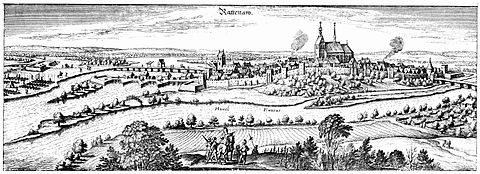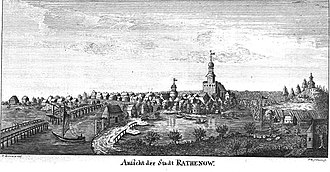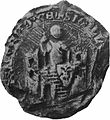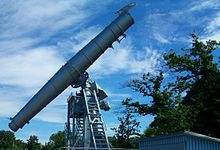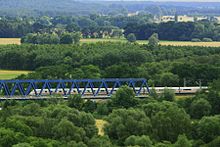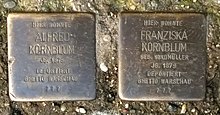Rathenow
| coat of arms | Germany map | |
|---|---|---|

|
Coordinates: 52 ° 36 ' N , 12 ° 20' E |
|
| Basic data | ||
| State : | Brandenburg | |
| County : | Havelland | |
| Height : | 29 m above sea level NHN | |
| Area : | 113.1 km 2 | |
| Residents: | 24,208 (Dec. 31, 2019) | |
| Population density : | 214 inhabitants per km 2 | |
| Postal code : | 14712 | |
| Area code : | 03385 | |
| License plate : | HVL, NAU, RN | |
| Community key : | 12 0 63 252 | |
| City structure: | 6 districts | |
City administration address : |
Berliner Strasse 15 14712 Rathenow |
|
| Website : | ||
| Mayor : | Ronald Seeger ( CDU ) | |
| Location of the district town of Rathenow in the Havelland district | ||
Rathenow [ ˈʁaːtʰənoː ] is an office-free city on the Havel , about 70 kilometers west of Berlin and the administrative seat of the Havelland district in Brandenburg . Since May 13, 2013, the city officially bears the additional designation “City of Optics”.
geography
Rathenow is located in the west of the Havelland district and borders the state of Saxony-Anhalt ( Stendal district ). The Havel flows through the city area.
climate
The city of Rathenow has a temperate climate. This is influenced from the east by the continental climate and from the west by the Atlantic maritime climate . The average annual rainfall for Rathenow is 536 mm. The driest month is February with a rainfall of 31 mm, while most of the rainfall falls in June with an average of 63 mm. The average annual temperature is 9 ° C . The statistically warmest month is July with an average of 18.2 ° C. The month of January, the coldest month of the year, has an average temperature of −0.2 ° C.
| Rathenow | ||||||||||||||||||||||||||||||||||||||||||||||||
|---|---|---|---|---|---|---|---|---|---|---|---|---|---|---|---|---|---|---|---|---|---|---|---|---|---|---|---|---|---|---|---|---|---|---|---|---|---|---|---|---|---|---|---|---|---|---|---|---|
| Climate diagram | ||||||||||||||||||||||||||||||||||||||||||||||||
| ||||||||||||||||||||||||||||||||||||||||||||||||
|
Monthly average temperatures and rainfall for Rathenow
Source: Climate-Data.org
|
||||||||||||||||||||||||||||||||||||||||||||||||||||||||||||||||||||||||||||||||||||||||||
City structure
According to the main statute, the following districts are identified:
Accommodation places are:
|
|
|
Within the urban area of Rathenow there are the districts or localities of the old town, Rathenow West (formerly the new lock), Rathenow East, northern settlement, forest settlement, southern settlement and suburban settlement.
history
The beginnings of settlements and development until the late Middle Ages
The area around Rathenow was already settled in prehistoric times . Several Slavic castle walls , such as the Stremmewiese castle wall, are detectable and have been preserved as castle stables . In 1157, in the area of today's Steckelsdorf district on the west bank of the Havel, the castle wall "Alt Rathenow" was mentioned, which is considered to be the origin of the city. The first written mention of the place as "Ratenowe" dates back to December 28, 1216, when the Brandenburg Bishop Siegfried II confirmed his archdeaconate rights to the Brandenburg Cathedral Chapter when he took office . In 1220 a late Romanesque cross basilica was built as a predecessor to today's Sankt-Marien-Andreas-Kirche on the Kirchberg. In 1288 the place receives jurisdiction. In 1295, Margrave Otto IV granted Rathenow town rights. From 1517 to 1562 the church was converted into a late Gothic hall church. In 1564 the town hall, which was destroyed in 1945, was built. The city suffered badly from the Thirty Years' War . In 1648 only 40 people lived in the city.
The city from the 17th to the 20th century
After the invasion of Sweden in 1674/75 , the Battle of Rathenow took place on June 25, 1675 during the Swedish-Brandenburg War , which the Brandenburg troops won. In the Battle of Fehrbellin , the Swedes suffered the decisive defeat three days later.
Rathenow is known as the cradle of industrial optics in Germany. In Rathenow, Johann Heinrich August Duncker developed the first multi-spindle grinding machine for the efficient production of spectacle lenses and founded the optical industry there in 1801. His son and later his grandson Emil Busch successfully continued the "Optische Industrie Anstalt". The later "Emil Busch AG" became one of the leading companies for optical products in Europe. In the middle of the 19th century, other large, medium and small businesses were founded, including what later became the second largest company "Nitsche & Günther". The brick industry was also known; A large part of the bricks for the buildings of Sanssouci Palace , the Dutch Quarter in Potsdam and the Red City Hall in Berlin come from Rathenow production. In the 19th century, the industry developed into an important employer in the region due to the ongoing construction boom in Berlin and Brandenburg. More than 50 companies were established along the Havel from Plaue to Havelberg. The "Rathenow" mark was stamped on all bricks. City brickworks had existed in the Rathenow urban area since the Middle Ages, and later brickworks were built on the banks of the Havel. After 1920, most of the brickworks were closed because the raw material was slowly running out and production became unprofitable.
After the reorganization of county breakdown in the Prussian state in 1816 Rathenow district seat of the was Westhavelland in the administrative district of Potsdam the province of Brandenburg . After the first district administrator of the new district Waldemar von der Hagen initially took over the administration from his estate in Hohennauen , he moved the district administrator's seat to Rathenow in 1824. The first district office was built on Berliner Straße, which was replaced by a new building, built by Franz Schwechten from 1893–1895 , on what was then Kaiser-Wilhelm-Platz, now Freedom Square. In 1851 Rathenow became a garrison town again after the last garrison had been withdrawn in 1848 after violent protests. The soldiers housed in the town houses were given new quarters in Bahnhofstrasse from 1889. The Zietenhusar barracks was built from 1889 to 1891 (simply structured brick buildings).
On June 1, 1925, the township of Rathenow left the Westhavelland district and from then on formed its own urban district , which was an enclave in the middle of the district. Rathenow with its district office remained the district town for Westhavelland.
During the National Socialist era, the Zietenhusar barracks housed a police riding school . The prayer house of the Jewish community at Fabrikenstrasse 2 was devastated during the November pogrom in 1938 and later converted into a children's home by the NSV . Today there is a facility of the Pestalozzi School for people with learning disabilities. During the Second World War , the National Socialists set up a subcamp of the Sachsenhausen concentration camp on Milower Landstrasse , in which at least 1,000 men (according to other sources also women) had to do forced labor in the Arado aircraft factories. In addition, at least 4975 forced laborers were exploited in 33 Rathenow camps and at least 2070 forced deportees were exploited in 12 Westhavelland camps (as of 1943/44). Emil Busch AG ran six of its own camps with at least 1,600 forced laborers (1943/44). All camps were assigned to the factories. In the work detachment of the prisoner- of- war camp STALAG IIIA (Lange Pannen) more than 166 prisoners were concentrated for forced labor.
Rathenow was hit by American air strikes on March 22, 1944, killing several people. On April 18, 1944, a bombing by a US bomber association killed 54 people, according to other sources 60 people, and 2,200 residents were homeless. Shortly before the end of the war in May 1945, some dispersed German troops fought together with the Volkssturm under the command of Field Marshal Keitel against the advancing Soviet troops, with more than 75 percent of the city being destroyed.
After 1945
Reconstruction of the destroyed city center began just one year after the war. Under the direction of Haesler, the first model buildings were erected at today's Platz der Jugend. In 1948 the former weavers' settlement Neufriedrichsdorf was incorporated. In 1950 Rathenow was revoked the status of an independent city. At the same time, the community of Neue Schleuse and the upstream magazine island became part of the urban area. With the administrative reform in the GDR in 1952, the city became the administrative seat of the Rathenow district .
On June 17, 1953, violent protests also arose in Rathenow in connection with the popular uprising . At the same time, the head of security for the HO business and SED member Wilhelm Hagedorn was lynched by angry demonstrators .
During the GDR era, several thousand people worked in the VEB Rathenower Optische Werke (ROW). A majority of the countries of the CMEA was supplied from here with eyeglasses and optical equipment. With the German monetary, economic and social union in 1990, these markets suddenly collapsed.
In November 1989, as in other cities in the GDR, there were protests. The first meetings took place in the Evangelical Luther Church. Then around 15,000 people gathered at the height of the protests and marched through the city to the Märkischer Platz demonstrating. Several round tables were held with representatives of the demonstrators and representatives of the city.
On December 6, 1993 Rathenow became district town of the Havelland district as part of the district reform. In the course of the official reform, the independent communities Böhne, Göttlin, Grütz, Semlin and Steckelsdorf as well as the city of Rathenow formed the Rathenow office.
The five municipalities mentioned above were incorporated into the city of Rathenow with effect from December 31, 2001, and the Rathenow office was dissolved at the same time.
Based on the qualified specialists available in the city in the field of the optical industry, the optics group Fielmann opened a new production and logistics center with 600 employees in the city in 2002.
In 2015 Rathenow was honored as “Municipality of the Year” in the state of Brandenburg by the savings bank association OSV for the positive urban development in recent years.
Nevertheless, there is a comparatively high level of unemployment in the city , while a two-decade-long emigration movement , especially of younger residents, was halted in the 2010s. Most of the buildings in the Rathenow Ost prefabricated building area - including more than a thousand residential units - have already been demolished.
Incorporations
- March 1, 1948: Neu Friedrichsdorf community
- July 1, 1950: New Schleuse community
- December 31, 2001: Municipalities of Böhne, Göttlin, Grütz, Semlin and Steckelsdorf
Population development
|
|
|
|
|
Territory of the respective year, number of inhabitants: as of December 31 (from 1991), from 2011 based on the 2011 census
politics
City Council
The Rathenow City Council consists of 28 members and the full-time mayor . Since the local elections on May 26, 2019 , the seats have been distributed among the individual parties or groups of voters as follows:
| Party / group of voters | Seats |
|---|---|
| CDU | 7th |
| The left | 7th |
| SPD | 4th |
| AfD | 4th |
| FDP | 2 |
| Alliance 90 / The Greens | 1 |
| Free voters Rathenow | 1 |
| NPD | 1 |
| The party | 1 |
(As of: local election on May 26, 2019 )
mayor
- 1990–2002: Hans-Jürgen Lünser (SPD)
- since 2002: Ronald Seeger (CDU)
Seeger was elected in the mayoral election on March 11, 2018 with 54.9% of the valid votes for a further term of eight years.
Coat of arms and seal
The city's coat of arms or seal was changed three times by the beginning of the 21st century. The first known seal comes from 1347:
Blazon : "Armored man (Mgf.) With a spear behind a wall, who carries a shield with an eagle in his left hand."
A changed seal then appeared around 1400. Probably due to the time when the rule was weak, it also disappeared from the seal:
Blazon: "Angel holds the eagle shield, next to which lies a bunch of grapes, an oak or a pine branch."
The current coat of arms was approved on March 18, 1993, but was introduced as early as 1939:
Blazon: "In silver, a red-tongued, gold-armored, feathered red eagle head, accompanied by three six-pointed blue stars on the sides and below."
flag
The city flag is white and includes an eagle's head. The stars are shifted on the mast side so that their central axis is 2/5 of the flag length.
Town twinning
Sister cities of the city are:
Sights and culture
In 2015 Rathenow was one of the venues for the first decentralized Federal Garden Show ( BUGA 2015 ). The event was held between April 18 and October 11, 2015 in Brandenburg an der Havel, Rathenow, Premnitz, Stölln and Havelberg, and had around 1.05 million visitors.
From April 22 to October 15, 2006, the state horticultural show of the state of Brandenburg under the title The colors on the trail attracted almost 500,000 people to Rathenow. For this purpose, extensive construction work had to be carried out in advance both on the vineyard and on the Schwedendamm site. A badly dilapidated mill was completely rebuilt. Before and during the garden show, it served as the LAGA GmbH office and houses a “green” classroom. Then the Rathenow Music School moved into the premises. The Rathenow Optics Park opened on April 28, 2007 on the grounds of the Rathenower State Horticultural Show .
In the next few decades, the Lower Havel should be renatured (see nature reserve Lower Havel South and North ) and the river regain its natural shape. This makes the course more curvy and the floodplains wider, which counteracts the risk of flooding.
The Rathenow cultural center (theater, optical industry museum, art exhibitions and restaurant) is located in the center of the city.

The Rolfsche telescope is a globally unique Brachymedial - telescope . It was built by engineer Edwin Rolf between 1949 and 1953 and stood on his private property until 1994. The telescope is a technical monument, was completely renovated from 1994 to 1996 and moved to the grounds of the Bruno H. Bürgel School. It has been in the Optikpark since December 6, 2008.
The Wolzensee nature reserve is located in the southeast of the city . The nature reserve Untere Havel Süd extends over an area of 3933 hectares of the Untere Havel from Rathenow to Havelsee .
Buildings
Rathenow has had one more landmark since the 2015 Federal Garden Show: the Weinbergbrücke , which cost around 10 million euros, with its two characteristic arches spans not only the Havel in an elegant curve, but also Hellers Loch, a body of water fed by an oxbow lake.
In the vicinity of St. Marien Andreas Church there are some preserved half-timbered houses that were restored in the 2010s. Otherwise, buildings from the post-war period shape the old town after it was almost completely destroyed in the war.
On Friedrich-Ebert-Ring there is an extensive residential complex made up of three- story row buildings , which was planned and built by the architect Otto Haesler (then still: Celle ) from 1929–1931 . It is the architecturally most important residential area of the Weimar Republic in the area of the later state of Brandenburg. During a renovation in the mid-1990s, the proportions of the facades were severely disturbed by the application of a thermal insulation system.
The architect Otto Haesler, who moved to the GDR after the Second World War , had presented a reconstruction plan for the war-torn town center of Rathenow, which was also based radically on the linear construction. This plan was only implemented in rudiments. In 1950/1951, Haesler was actually able to build a number of buildings around the Platz der Jugend in the old town. They are based on the designs of the architect of the twenties - for example with the motif of the bay-like protruding, glazed stairwells - but no longer achieve their elegance. Shortly afterwards, the “National Tradition” architectural style became mandatory in the GDR ; in this respect, the Haesler buildings in Rathenow's old town are a rare example of socially committed architecture in the style of the pre-war avant-garde in the early days of the GDR.
Churches
Protestant churches
The Protestant St. Marien Andreas Church in the old town was built in the late Romanesque style at the beginning of the 13th century and converted into a three-aisled hall church in the 15th and 16th centuries according to plans by Master Lindemann. It was rebuilt after being severely damaged in the Second World War.
Other Protestant churches are the Church of the Resurrection, a brick building by Curt Steinberg built as a cemetery chapel from 1914 to 1917 , and the Luther Church, built in 1932 in the New Building style. In addition, there is a regional church community in Rathenow and other Protestant churches in the districts of Rathenow.
Association of Evangelical Free Churches
The Association of Evangelical Free Churches is represented in Rathenow with two parishes. The Evangelical Free Church Community ( Baptists ) has had its community center at Berliner Strasse 29 since 2011 . The Seventh-day Adventist Church is located in Friedrich-Engels-Str. 26th
Catholic churches
The first Catholic church in Rathenow since the Reformation was consecrated in 1893 as the Church of St. Georg . The church was left unfinished. Your parish belongs to the Archdiocese of Berlin . Another Catholic church is located on Horstenweg in the Steckelsdorf district (expansion). It is the St. Josef Church , consecrated in 1962 . Today this church belongs to the parish of St. Elisabeth, based in Tangermünde , and thus to the diocese of Magdeburg .
Other religious communities
Other religious communities are also represented in Rathenow. The New Apostolic congregation, which was founded in 1908, has its church at Kleine Hagenstrasse 7–8. Members of the Church of Jesus Christ of Latter-day Saints gather at 50 Heinrich-von-Rosenberg-Strasse and Jehovah's Witnesses gather at 48a Genthiner Strasse. The Apostle Ministry of Jesus Christ also has a parish in Rathenow. The meeting point is Große Milower Straße 3a.

Monuments

- The monument to the “Great Elector” Friedrich Wilhelm , who defeated the Swedes in the Battle of Fehrbellin in 1675, stands on the Schleusenplatz . The monument was created between 1736 and 1738 by Johann Georg Glume based on a model by Bartholomé Damart and is considered the most important baroque sandstone monument in northern Germany. It shows the elector in the costume of a Roman emperor on a pedestal to which allegories and battle reliefs are attached.
- The 32 m high Bismarck Tower , inaugurated in 1914 and built in honor of Otto von Bismarck , who was born near Rathenow in Schönhausen / Elbe , stands on the vineyard, a recreation park close to the city center (part of the State Garden Show in 2006) . The tower was badly damaged in 1945, attempts were made to convert it into an observatory in the 1960s, and in 2003 it was re-inaugurated after renovation.
- Memorial to the victims of fascism (from 1951) on the step substructure of the Kaiser Wilhelm I monument , which was melted down in 1942, on Freedom Square
- Memorial for the resistance fighters against National Socialism in the municipal cemetery west of Grosse Milower Strasse for 98 slave laborers from different countries. 56 other victims of forced labor are buried in the same cemetery
- Memorial for forced laborers and their children on the “Foreigners Cemetery” established in 1943 in a forest between Bammer Landstrasse and the B188, to be reached via Neufriedrichsdorfer Strasse
- Jewish cemetery with a memorial stone for the Jewish citizens of the city killed by the National Socialists on Neufriedrichsdorfer Straße
- Memorial plaque on the former prayer room of the Jewish community at Fabrikenstrasse 2 in memory of the exterminated community
- Memorial plaque on the Protestant village church of the Steckelsdorf district for the Jewish victims of the Landwerk ( Hachschara ) retraining organization at Horstenweg 5/6
- Memorial plaque for pastor August Froehlich at the rectory of St. Georg Rathenow in Friesacker Strasse
See also: List of architectural monuments in Rathenow with the architectural monuments entered in the monuments list of the state of Brandenburg.
Economy and Infrastructure

dish
The city is the seat of the Rathenow District Court, which is responsible for the western part of the Havelland district .
Optical industry
The economic development of the city of Rathenow is closely linked to the development of the optical industry. After the establishment of the later Rathenower Optical Works (ROW), up to 300 companies in the optical industry settled in Rathenow from the end of the 19th century.
Several thousand people worked in this field for many decades. After 1949, for example, Rathenow became the sole manufacturing site for eyeglass lenses in the GDR . Some of the successor companies to ROW that were privatized after 1990 are still active in the optical industry (e.g. microscope construction by Askania).
traffic
Road traffic
Rathenow is at the intersection of the federal highways B 102 (direction Brandenburg an der Havel and Neustadt (Dosse) ) and B 188 (direction B 5 Hamburg – Berlin and Stendal).
Rail transport
Rathenow station is on the Berlin – Hanover and Brandenburg – Neustadt (Dosse) railway lines . There are the following connections in regional traffic: RE 4 via Berlin to Ludwigsfelde , RB 34 to Stendal and RB 51 to Brandenburg an der Havel . From December 2007 to December 2009 trains on the IC line Stettin – Berlin – Amsterdam also stopped here, and from April to October during the BUGA 2015 trains on the IC line Berlin – Amsterdam.
From April 2, 1900 to 1945, Rathenow was the exit station of the Rathenow-Senzke-Nauen district railway . The connection to Neustadt (Dosse) was discontinued at the end of 2003, the section from Rathenow to Rathenow-Nord at the end of 2005.
Bus transport
In and around Rathenow buses run by the Havelbus Verkehrsgesellschaft, which connect the individual districts and the surrounding towns and communities with Rathenow.

Shipping
Due to Rathenow's location on the Havel, shipping can be operated. There is a harbor and a landing stage for excursion boats to Havelland.
Air traffic
There are private and commercial air traffic in Stechow , about eight kilometers northeast of the city; the nearest international airport is Berlin-Tegel Airport , 65 kilometers away.
education
In Rathenow there are the four primary schools Am Weinberg , Friedrich Ludwig Jahn , Geschwister Scholl and the primary school Otto Seeger in Rathenow-West. The Friedrich-Ludwig-Jahn-Gymnasium , the Bruno-H.-Bürgel-Gesamtschule and the Oberschule Johann Heinrich August Duncker exist as secondary schools . There is also a school for the mentally handicapped spectrum and the general special school JH Pestalozzi , two special schools in Rathenow.
The Geschwister Scholl primary school will be closed at the end of the 2016/17 school year and merged with the Am Weinberg primary school .
Further educational institutions are the Rathenow Music School, the Havelland Music, Art and Adult Education Center, the Havelland Upper School Center and the Brandenburg State's Ophthalmic Education and Technology Center.
Sports
The club FSV Optik Rathenow plays in the Regionalliga Nordost in the 2018/19 season .
Personalities
Honorary citizen
- Friedrich von Wrangel (1784–1877), Prussian Field Marshal General ; since 1856
- Johann Friedrich Meuß (1813–1878), pharmacist and brickworks owner; since July 26, 1877
- Otto von Bismarck (1815–1898), was once elected to the Prussian state parliament with the votes of the Rathenow electors and began his political career; since June 15, 1875
- Max Hobrecht (1827–1899), writer, politician, steam mill owner, since December 13, 1897
- Friedrich Lange (1844–1916), mayor of Rathenow for 27 years; since July 16, 1906
- Karl Mertens (1903–1988), sculptor; since 1987
- Erika Guthjahr, b. Pelzer (1916–2005), painter, writer and local history researcher; since September 12, 1996
- Günter Thonke (* 1928); since May 6, 2009, master baker, local researcher
- Klaus Eichler (* 1939); since May 6, 2009, former chief engineer at the Premnitz man-made fiber plant and head of the infrastructure department at the Brandenburg Ministry of Infrastructure
sons and daughters of the town
To 1900
- Stephan Bodecker (1384–1459), Bishop of Brandenburg
- Peter von Meinicke (1701–1775), Royal Prussian Major General and Chief of Dragoon Regiment No. 3
- Joachim Christian Blum (1739–1790), poet
- Johann Heinrich August Duncker (1767–1843), founder of the German optical industry
- Wilhelm Schneider (1781–1811), pianist and composer
- Friedrich Meier (1785–1815), painter, participant in the wars of liberation
- Ferdinand Löwe (1787–1832), actor
- Friedrich Adolf Ahlert (1788–1833), architect, Cologne cathedral builder
- Wilhelm Biese (1822–1902), piano maker and piano manufacturer
- Karl Adolph Paalzow (1823–1908), physicist
- Gustav Hermann von Alvensleben (1827–1905), military
- Gustav Neumann (1832–1885), geographer and educator
- Friedrich Wilhelm Kaeding (1843–1928), stenographer
- Friedrich Schultze (1848–1934), neurologist
- Oskar von Wackerbarth (1862–1937), manor owner and district administrator of the Cottbus district
- Alfred zur Nieden (1868–1957), district administrator and chief of police in Gelsenkirchen
- Friedrich Wilhelm Eue (1888–1937), engraver and medalist
- Otto Weber (1889–1972), politician (KPD)
- Käthe Miethe (1893–1961), writer
- Albert Gustav Bunge (1893–1967), metal and enamel artist and painter
- Fritz Weber (1894–1944), (SPD), member of the People's Day of the Free City of Danzig
- Walter Donat (1898–1970), Japanologist
- WH Lippert (1898–1981), sculptor, painter and graphic artist
- Georg Mierdel (1899–1987), electrical engineer, physicist and university professor
1901 to 1950
- Hans-Joachim Geyer (1901–1972), author and agent
- Karl Albrecht (1902–1976), economist
- Karl Mertens (1903–1988), sculptor
- Kurt-Christoph von Knobelsdorff (1904–1945), tournament rider
- Willy Rutsch (1904–1989), politician (CDU)
- Kurt Laube (1905–1987), communist resistance fighter, interbrigadist and functionary of the VVN
- Walter Mönch (1905–1994), Romance studies and literary scholar
- Joachim Mrugowsky (1905–1948), doctor and Nazi criminal
- Wolfgang Imle (1909-2001), politician (FDP)
- Günter Scheel (1924–2011), historian and archivist
- Wolfgang Gruner (1926–2002), cabaret artist, actor and director
- Hans-Christoph Schröder (1933–2019), historian
- Immo Stabreit (* 1933), diplomat
- Hans-Joachim Geffert (1935–2019), local history researcher and writer
- Hans-Günter Naumann (1935–2010), politician (SPD), 1970–1994 member of the Bavarian State Parliament (SPD)
- Dietrich Weber (1935–2008), German and literary scholar
- Peter Rabenalt (* 1937), film composer and scholar, born in today's Semlin district
- Bernd Rabehl (* 1938), sociologist
- Heinz Bartsch (* 1939), ergonomist and engineer
- Rosemarie Köhn (* 1939), 1993-2006 bishop of Hamar (Norway) (second woman worldwide as a Lutheran bishop)
- Elke Wendt-Kummer (* 1941), screenwriter, director and translator
- Kurt-Dieter Grill (* 1943), politician (CDU), 1994–2005 member of the Bundestag
- Barbara Heinisch (* 1944), painter
- Wulf Herzogenrath (* 1944), art historian and curator
From 1951
- Gerhard Günther (1955–2015), Potitiker (CDU), 2004–2014 member of the Thuringian state parliament
- Christoph Dieckmann (* 1956), journalist and author
- Ronald Seeger (* 1956), Mayor of Rathenow, born in Göttlin
- Harald Goldau (* 1957), mechanical engineering professor
- Jörg Friedrich (* 1959), rower
- Ralf Scherrer (* 1959), artist
- Jörg Freimuth (* 1961), athlete
- Uwe Freimuth (* 1961), athlete
- Christian Görke (* 1962), politician (Die Linke), former Finance Minister of the State of Brandenburg
- Kay Nerstheimer (* 1964), politician (AfD)
- Stephan Schill (* 1964), actor
- Christian Rudolf (* 1965), actor, presenter and singer
- Kerstin Köppen (* 1967), rower
- Mario Streit (* 1967), rower
- Ralf Pleger (* 1967), filmmaker and director
- Jörg Heinrich (* 1969), football player, born in today's Böhne district
- Christian Beeck (* 1971), soccer player
- Stefan Rudolf (* 1974), actor
- Marco Tschirpke (* 1975), music cabaret artist
- Florian Foest (* 1976), cameraman
- Katrin Bühring (* 1977), actress
- Katja Poschmann (* 1980), politician (SPD)
- Julia Mitrici (* 1982), actress
- Christian Sturm-Willms (* 1987), cook
- Colett Rampf (* 1991), triathlete, duathlete, soccer player
- Dennis Mast (* 1992), soccer player
- Johna Fontaine (* 2000), child actress
Other personalities associated with the city
- Samuel Christoph Wagener (1763–1845), field preacher in Rathenow, writer
- Emil Busch (1820–1888), industrialist of precision mechanics and optics, lived in Rathenow
- Egmont von Rauch (1829–1875), Colonel and Commander of the Hussar Regiment “von Zieten” (Brandenburgisches) No. 3 in Rathenow from 1871–1875
- Heinrich von Rosenberg (1833-1900), General of Cavalry , Commander of Hussars "from Zieten" in Rathenow from 1875-1883, successful amateur - jockey
- August Froehlich (1891–1942), Roman Catholic priest, pastor in Rathenow, resistance fighter against the Nazi regime, died in Dachau concentration camp
- August Hild (1894–1982), writer, lived in Rathenow since 1939
- Käthe Korth (1902–1982), writer, lived in Rathenow for a few years
- Regina Thoss (* 1946), singer, lived in Rathenow for a few years
- Victoria Herrmann (* 1969), TV presenter, grew up in Rathenow and completed an apprenticeship at Rathenower Optical Works
literature
- Matthias Hardt : Rathenow. Havelland district (73 km wnw Berlin) . In: Lieselott Enders , Evamaria Engel , Gerd Heinrich , Winfried Schich (eds.): City book Brandenburg and Berlin (= Peter Johanek , Franz-Joseph Post, Klaus Meyer-Schwickerath in the Institute for Comparative Urban History at the University of Münster [ed.]: German City book, handbook of urban history, volume 2). Verlag W. Kohlhammer, Stuttgart / Berlin / Cologne 2000, ISBN 3-17-015388-9 , pp. 436-444.
- Sebastian Kinder, Haik Thomas Porada on behalf of the Leibniz Institute for Regional Geography Leipzig and Saxon Academy of Sciences in Leipzig (ed.): The Havelland around Rathenow and Premnitz (= landscapes in Germany. Values of the German homeland . Volume 74). Böhlau Verlag, Cologne / Weimar / Vienna 2017, ISBN 978-3-412-22297-0 .
- Samuel Christoph Wegener: Memories of the Churmärkischen city Rathenow. With four coppers. Berlin 1803 ( e-copy ).
Web links
- Steckelsdorf in the RBB program Landschleicher on November 2, 2008
- Info Rathenow Rathenow and its history
Individual evidence
- ↑ Population in the State of Brandenburg according to municipalities, offices and municipalities not subject to official registration on December 31, 2019 (XLSX file; 223 KB) (updated official population figures) ( help on this ).
- ^ Message from the Brandenburg Ministry of the Interior
- ↑ Climate data
- ↑ General Statute of the City of Rathenow from April 20, 2011 PDF
- ^ Service portal of the state administration Brandenburg. City of Rathenow
- ↑ On the history - forced labor: RAA Brandenburg, Interkultur. Contribution No. 17 “Foreign workers in the Nazi era”, pages 20–35
- ^ Archive Culture Center Rathenow; Emil Busch AG Rathenow files, Berliner Str. 5; Barracks camp - construction documents, lease and rental agreements
- ^ Märkische Allgemeine Zeitung - reports 2001–2002 by contemporary witnesses
- ↑ Brochure "Forced Labor During the Fascist Era in Rathenow / Westhavelland" by Dieter Seeger (2012)
- ↑ Rathenow - the city of optics, on www.mein-rathenow.de
- ^ History of Rathenow, on www.rathenow.de
- ↑ Death in Rathenow . In: Der Spiegel . No. 25 , 2003 ( online ).
- ^ Dissolution of the Rathenow office. Communication from the Ministry of the Interior of October 8, 2001. Official Journal for Brandenburg - Joint Ministerial Gazette for the State of Brandenburg, Volume 12, Number 44, Potsdam, October 30, 2001, p. 694 PDF
- ↑ Märkische Allgemeine, Potsdam, Brandenburg, Germany: Honored by the Sparkassenverband - Rathenow is the "Commune of the Year" / Havelland / Local - MAZ - Märkische Allgemeine. In: Märkische Allgemeine Zeitung. Retrieved April 11, 2016 .
- ↑ a b Contribution to the statistics of the State Office for Data Processing and Statistics. Historical municipality register of the State of Brandenburg 1875 to 2005 19.5 District Havelland PDF
- ^ Incorporation of the communities Böhne, Göttlin, Grütz, Semlin and Steckelsdorf into the city of Rathenow. Announcement of the Minister of the Interior of October 8, 2001. Official Gazette for Brandenburg - Joint Ministerial Gazette for the State of Brandenburg, Volume 12, Number 44, p. 694 of October 30, 2001 PDF
- ^ Historical municipality register of the state of Brandenburg 1875 to 2005. District Havelland . Pp. 22-25
- ↑ Population in the state of Brandenburg from 1991 to 2015 according to independent cities, districts and municipalities , Table 7
- ^ Office for Statistics Berlin-Brandenburg (Ed.): Statistical report AI 7, A II 3, A III 3. Population development and population status in the state of Brandenburg (respective editions of the month of December)
- ↑ Local elections on May 26, 2019
- ↑ Local elections October 26, 2003. Mayoral elections , p. 25
- ↑ Brandenburg Local Election Act, Section 74
- ^ Result of the mayoral election on March 11, 2018
- ↑ Evamaria Engel, Lieselott Enders , Heinrich Schich (ed.): City book Brandenburg and Berlin . Stuttgart 2000, page 443.
- ↑ Coat of arms information on the service portal of the state administration of Brandenburg
- ↑ https://www.oimr.de/
- ↑ Märkische Allgemeine, Potsdam, Brandenburg, Germany: Bridge baptism with thousands of Havelländer - First test of the Rathenower Buga Bridge / Havelland / Local - MAZ - Märkische Allgemeine. In: Märkische Allgemeine Zeitung. Retrieved April 11, 2016 .
- ↑ a b The information in this section is taken from the following website: rathenow.de: Kirchen - Religionen ; accessed on June 3, 2017
- ^ Kurfürstendenkmal - Rathenow - Sights - Tourism & Culture - City of Rathenow. Retrieved June 12, 2020 .




